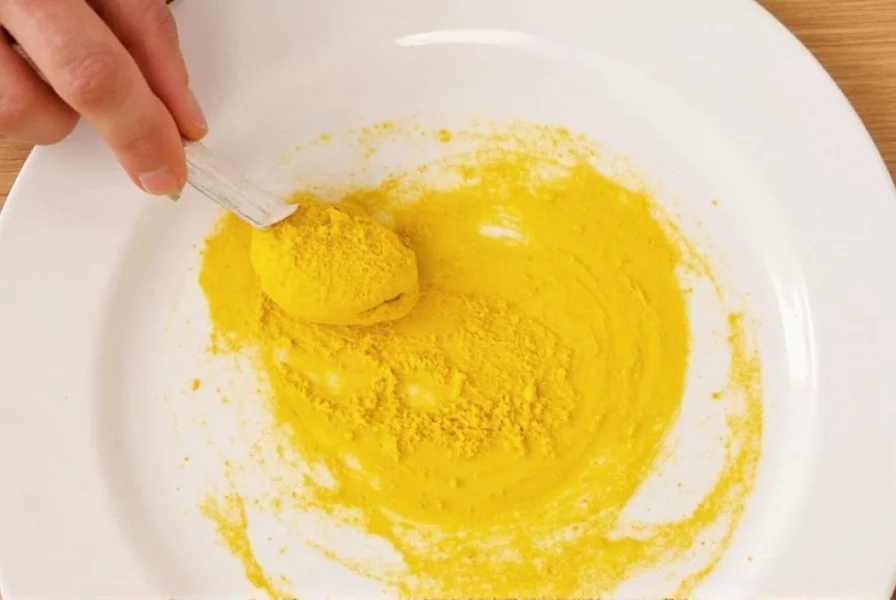Those vibrant yellow-orange turmeric stains that seem to magically appear on your favorite white shirt or kitchen counter aren't permanent—if you act fast. Turmeric contains curcumin, a powerful natural dye that bonds strongly with fabrics and surfaces, making these stains particularly stubborn. The key to successful removal lies in understanding turmeric's chemistry and using the right approach for your specific material.
Why Turmeric Stains Are So Difficult to Remove
Turmeric's active compound, curcumin, creates what's known as a "luminophore"—a molecule that strongly adheres to surfaces and resists typical cleaning methods. Unlike many food stains that break down with water, turmeric actually becomes more difficult to remove when exposed to heat or alkaline substances. This explains why many people find their turmeric stains turn reddish or become permanently set after washing in hot water.
Immediate Action: First Steps for Fresh Turmeric Stains
When you notice a fresh turmeric spill, your response in the first 5-10 minutes determines whether the stain becomes permanent. Follow these critical first steps:
- Blot, don't rub - Use a clean white cloth to gently absorb excess turmeric without spreading it
- Cold water rinse - Hold the stained area under cold running water from the back of the fabric to push the stain out, not deeper in
- Avoid heat - Never use hot water initially, as it sets turmeric stains permanently
- Pre-treat immediately - Apply one of the solutions below before the stain dries
Most Effective Turmeric Stain Removal Methods
Different materials require specific approaches. Here's what actually works for various surfaces:
For Clothing and Fabric
| Stain Type | Recommended Method | Time Required |
|---|---|---|
| Fresh stain on white fabric | Baking soda paste (3 parts baking soda, 1 part dish soap) | 30-60 minutes |
| Set-in stain on white fabric | Hydrogen peroxide (3%) soak | 2-4 hours |
| Fresh stain on colored fabric | Vinegar solution (1:1 white vinegar to cold water) | 15-30 minutes |
| Set-in stain on colored fabric | Lemon juice and sunlight treatment | 2-6 hours |
Detailed Fabric Treatment Instructions
Baking Soda and Dish Soap Method (Best for Fresh Stains)
Create a thick paste using three parts baking soda to one part clear dish soap. Apply generously to the stain, gently working it into the fibers with an old toothbrush. Let sit for 30-60 minutes before rinsing with cold water. This method works particularly well for how to get turmeric out of white clothes without damaging the fabric.
Vinegar Solution (Ideal for Colored Fabrics)
Mix equal parts white vinegar and cold water. Soak the stained area for 15-30 minutes, then rinse thoroughly with cold water. For stubborn stains, repeat the process. Many users searching for does vinegar remove turmeric stains will find this method effective for most colored fabrics.
Lemon Juice and Sunlight (Natural Bleaching for Colored Fabrics)
Squeeze fresh lemon juice directly onto the stain, then place the fabric in direct sunlight. The combination of citric acid and UV rays breaks down the curcumin molecules. Check every 30 minutes and reapply lemon juice as needed. This is one of the safest natural remedies for turmeric stains on delicate or colored fabrics.
Hydrogen Peroxide (For White Fabrics Only)
Apply 3% hydrogen peroxide directly to set-in stains on white fabrics. Let sit for 2-4 hours before washing as usual. Never use on colored fabrics as it may cause discoloration. This method proves highly effective for those searching for the best way to remove turmeric stains from fabric that have already dried.
For Kitchen Surfaces and Countertops
Turmeric stains on granite, quartz, or laminate countertops require different approaches than fabric:
- For sealed stone surfaces: Make a paste of baking soda and hydrogen peroxide, apply to the stain, cover with plastic wrap, and let sit for 1-2 hours before wiping clean
- For unsealed wood: Use a paste of baking soda and olive oil (not water-based solutions which can damage wood)
- For laminate surfaces: A magic eraser (melamine foam) with water often works best for turmeric stain removal for kitchen countertops

What NOT to Do With Turmeric Stains
Avoid these common mistakes that make turmeric stains permanent:
- Using hot water - Heat sets turmeric stains permanently
- Applying heat - Don't use hair dryers or put stained items in the dryer until the stain is completely gone
- Using chlorine bleach - Can turn turmeric stains bright red or orange
- Rubbing vigorously - Spreads the stain and damages fabric fibers
- Waiting too long - The longer turmeric sits, the harder it becomes to remove
Preventing Future Turmeric Stains
Prevention is always better than removal:
- Wear an apron when cooking with turmeric
- Use glass or stainless steel containers instead of plastic (turmeric stains plastic permanently)
- Immediately rinse any turmeric spills with cold water
- Consider using turmeric powder in a small mesh strainer for controlled application
When to Seek Professional Help
For valuable items like silk, wool, or dry-clean-only garments, or for large set-in stains on upholstery, professional cleaning may be necessary. Attempting home remedies on delicate fabrics can sometimes cause more damage than the stain itself.










 浙公网安备
33010002000092号
浙公网安备
33010002000092号 浙B2-20120091-4
浙B2-20120091-4